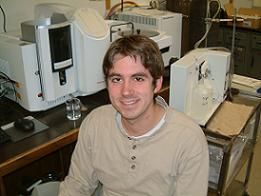Analysis of Associated Bedrock-Aquifer System Sediments: Origins of Electron Donor-Rich Aquifers in Eastern North Dakota

Ryan Klapperich is an M.S. (Geology) student at the University of North Dakota in Grand Forks, ND. He graduated with a B.S. in Geology from UND in May of 2005. As an undergraduate, Ryan developed an interest in hydrogeology which led him to continue with his Masters at the University of North Dakota. Ryan’s research interests include denitrification, hydrogeochemistry, and bedrock-aquifer relationships. His Master’s Degree project combines aspects of denitrification research with traditional sedimentological study.
Email: ryan.klapperich@und.edu
Fellow: Ryan Klapperich, Geology and Geological Engineering Department, UND
Advisor: Dr. Scott F. Korom, Associate Professor of Geology, University of North Dakota
Matching Support: UND
Degree Progress: M.S. in Geology expected December 2007
Analysis of Associated Bedrock-Aquifer System Sediments: Origins of Electron Donor-Rich Aquifers in Eastern North Dakota
Nitrate pollution has long been recognized as the most prevalent form of groundwater pollution. The only effective process to remediate nitrate contaminants is denitrification, typically through natural attenuation. This process reduces nitrate (NO 3 -) to harmless nitrogen gas. The process occurs naturally, requiring only an oxygen-limited environment, the presence of nitrogen digesting bacteria, and the availability of electron donors. The three most common electron donors are organic carbon, sulfide (typically as pyrite, FeS 2), and ferrous iron minerals. Research has also shown that the controlling factor in this reaction has typically been the availability of suitable electron donors within the aquifer sediments.
The long-term goal of this research is to develop an aquifer nitrate vulnerability index based on the supply of electron donors in the aquifer sediments. This project contributes toward that goal by considering the abundance of electron donors in the likely parent materials comprising the aquifer sediments. Based on the experience of previous UND denitrification research and literature reports, shale units are more likely to have large supplies of electron donors than other regional rock types. Shale is relatively soft and easily weathered and comprises much of the bedrock in eastern North Dakota. Therefore, shale units are the most likely contributors to sediments in nearby aquifers. My hypothesis is that regional bedrock units rich in electron donors should correlate to nearby aquifer sediments that are potentially rich in electron donors. The practical utility of this work is that an initial list of aquifers with potentially high denitrification capacities in North Dakota may be made using geological investigations. Later, more extensive and more expensive geochemical analyses would be necessary to confirm the denitrification capacity of specific aquifers and specific aquifer sites. However, much of the initial work could be done with data already available and in conjunction with future drilling performed by the North Dakota State Water Commission (NDSWC).
Project Objectives:
- Conduct a literature review on the electron donor capacity of eastern North Dakota shale bedrock units.
- Collect bedrock samples in conjunction with the NDSWC in the Summer of 2006. Conduct X-Ray Diffraction (XRD) and electron donor analysis on these samples.
- Identify and analyze related bedrock cores from eastern North Dakota currently stored in the North Dakota State Core Library in Grand Forks, ND.
- Investigate a link between the denitrification capacities of eastern North Dakota aquifers with the electron donor composition of the surrounding bedrock.
- If possible, develop a qualitative index (low, medium, and high) of aquifer denitrification capacity based on the probable source of the parent material.
Progress to Date:
A literature review of eastern North Dakota shales is underway. Sampling of bedrock units below the Galesburg-Paige aquifer (located near Galesburg, ND) will occur in early to mid-June in conjunction with the ND State Water Commission. Bedrock cores housed in the ND State Core library have been identified and samples will be analyzed during the summer and fall of 2006.
Significance:
This research will investigate the link between the denitrification capacities of eastern North Dakota aquifers with the electron donor composition of the surrounding bedrock. If such a link is possible, a qualitative index (low, medium, and high) of aquifer denitrification capacity based on the probable source of the parent material will be developed. This index could then be used to focus, in a cost-effective fashion, more extensive and expensive geochemical analysis on specific aquifers or zones in specific aquifers.

Scott F. Korom
Geology & Geological Engineering
UND


